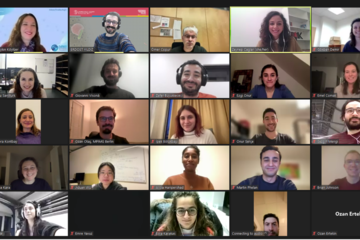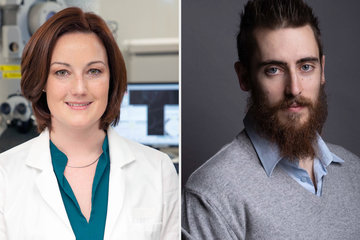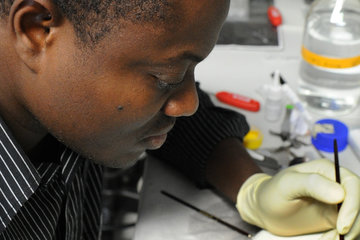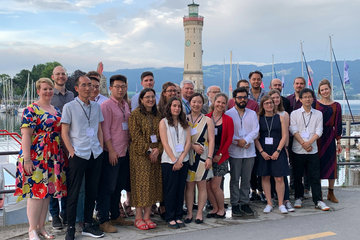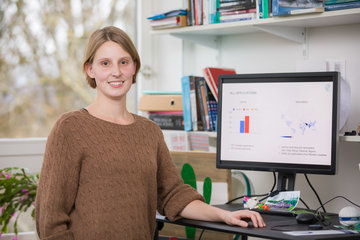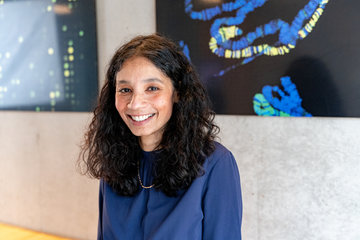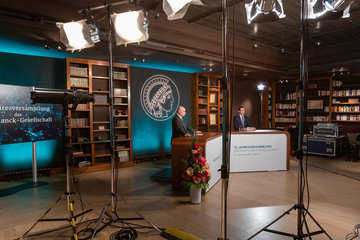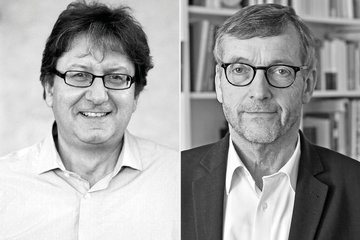FAQs: Lise Meitner Excellence Program
Whom we are looking for / Application procedure / Selection process
A. Target group
Who is the Lise Meitner Excellence Program (LME) aimed at?
The Lise Meitner Excellence Program has been created for highly talented young women scientists who received their doctorates no more than nine years ago (family breaks are taken into consideration accordingly). The Max-Planck-Gesellschaft has established the program in the hope that it will be able to significantly increase the number of female scientists in management positions. Applicants of all genders are welcome.
The Lise Meitner Program expressly serves the objective of counteracting an existing under-representation of female scientists in the Max Planck Gesellschaft at the W2 career level. In a legal sense, this Program understands itself as a positive measure in favour of the under-represented gender. Applications by women therefore enjoy priority within the boundaries of what is legally permissible. Any preferential consideration of female scientists is excluded if reasons worthy of legal protection, which lie in the qualification and/or person of another candidate, prevail.
What are the criteria for applications to succeed?
You should be able to provide evidence of initial steps towards scientific independence during the early stages of your career in science, e.g. in the form of independent projects, and be able to show outstanding innovative scientific achievements. You should ideally also have already acquired initial experience as a group leader. Another selection criterion is the thematic fit with a suitable institute.
Is there an age limit?
There is no age limit. You should already have gained some leadership experience as a talented young scientist and ideally not have completed your doctorate more than nine years ago at the time of your application to head a Lise Meitner Group. Please provide a detailed description in your cover letter of why you remain eligible for the program if this limit has been exceeded in your specific case.
How do family breaks affect the postdoctoral period?
The Max-Planck-Gesellschaft expressly welcomes applications from young female scientists who were awarded their doctorates more than nine years ago and haven’t been able to apply sooner as a result of family related breaks or interruptions. We therefore ask about family-related interruptions or breaks in the application form of the application database. Please inform us about these breaks or interruptions not only in the database but set out these times also in the cover letter so that they can be considered during the selection process
Are there fixed regulations regarding the crediting of family-related interruptions in relation to the time after finishing the PhD?
No, there is no fixed regulation. Each application is assessed individually and is decided on a case-by-case basis. It is therefore important to inform us of any family-related interruptions in the application database and in the cover letter.
B. Application process
There are so called “Sections” mentioned. What does this mean and in which Section should I apply?
The Max Planck Institutes conduct research in the fields of life sciences, natural sciences and the humanities. Although this is very difficult, as many institutes work on an interdisciplinary basis, for example, the institutes are divided into three so-called Sections:
- The Biology and Medicine Section
- The Human Sciences Section
- The Chemistry, Physics and Technical Section
You do not have to actively apply for a section. By choosing one of the available Research Areas you have to choose in the application database, you will automatically be assigned to a section.
The assignment of the Research Areas to the respective Sections can be found below.
Which Research Area in the application database belongs to which Section?
Biology and Medicine Section (BMS):
- Biochemistry, Structrual Biology, Chemical Biology, Biophysics
- Cell and Developmental Biology, Genetics
- Computational Biology, Big Data, Machine Learning / AI
- Immunobiology, Molecular Medicine, Microbiology
- Neurobiology and Behavior
- Organismic Biology, Ecology and Evolution
Human Science Section (GSHS):
- Cultural Sciences and Jurisprudence
- Human Cognitive and Brain Sciences & Natural Sciences
- Law and Economics
- Social- and Behavioral Sciences
Chemistry, Physics and Technical Section (CPTS) à Host letter required (see below)
- Astronomy and Astrophysics
- Chemistry
- Complex Systems
- Computer Science and Mathematics
- Earth Sciences
- Materials Research
- Physics
Which documents are required for an successful application?
For all applications
(Biology and Medicine Section; Human Sciences Section; Chemistry, Physics and Technical Section)
Please submit the following documents with your application for the position:
- A cover letter,
- a curriculum vitae,
- a list of publications,
- a one-page summary of scientific achievements (written for a non-specialist; (11 point type, double spaced, times new roman, 25mm margins on 4 sides)),
- a research statement (written for a specialist; 11 point type, double spaced, times new roman, 25mm margins on 4 sides) including all references, figures, and tables, written for a specialist)
- of three pages in the Biology and Medicine Section
- of five pages in the Human Sciences Section and Chemistry, Physics and Technical Section
- copies of three most important publications,
- names and contact details of three other scientists as experts in your research area
combined in one PDF file.
You are also required to invite two reviewers to upload recommendation letters for you to the application portal.
Only necessary for applications in the Chemistry, Physics and Technical section (CPTS):
If you wish to apply for research field in the CPTS you must submit a so-called
- host letter
from one or more Max Planck Institute of the CPTS in addition to the regular application documents.
This must be included in your PDF file (see above).
What is a host letter and how to receive it?
The host letter must include the commitment of a Max Planck Institut (MPI) in the CPTS to accept you as a Lise Meitner Group Leader if your application is successful.
Please contact one or more MPIs in advance of your application with a request for a host letter. Please send your enquiry to the Managing Director of the respective MPI, who can be found on the MPI homepage. He/She/Them should then provide the host letter and hand it over to you so that you can upload it together with your other application documents via the database (one PDF file). You have to submit at least one host letter for a successful application. However, it is also possible to submit several host letters.
There are no formal criteria for the preparation of the host letter and the submission by the MPI is neither necessary nor possible. Without a host letter, the formal criteria relating to the application documents are not fulfilled.
Which Max Planck Institutes belong to the Research Areas of the Chemistry, Physics and Technical Section and can therefore be contacted regarding a Host Letter?
Chemistry, Physics and Technical Section:
Astronomy/Astrophysics
MPI für Astronomie, Heidelberg
MPI für Astrophysik, Garching
MPI für extraterrestrische Physik, Garching
MPI für Gravitationsphysik, Hannover / Potsdam-Golm
MPI für Radioastronomie, Bonn
Earth Sciences
MPI für Biogeochemie, Jena
MPI für Chemie, Mainz
MPI für Meteorologie, Hamburg
MPI für Sonnensystemforschung, Göttingen
Materials Research
MPI für Chemische Physik fester Stoffe, Dresden
MPI für Eisenforschung, Düsseldorf
MPI für Festkörperforschung, Stuttgart
MPI für Mikrostrukturphysik, Halle
MPI für Struktur und Dynamik der Materie, Hamburg
Chemistry
MPI für Chemische Energiekonversion, Mülheim (ehem. MPI für bioanorganische Chemie)
Fritz-Haber-Institut, Berlin
MPI für Kohlenforschung, Mülheim
MPI für Kolloid- und Grenzflächenforschung, Potsdam-Golm
MPI für Polymerforschung, Mainz
Computer Science / Mathematics
MPI für Informatik, Saarbrücken
MPI für Mathematik, Bonn
MPI für Mathematik in den Naturwissenschaften, Leipzig
MPI für Softwaresysteme, Saarbrücken / Kaiserslautern
MPI für Sicherheit und Privatsphäre, Bochum
Complex Systems
MPI für Intelligente Systeme, Stuttgart/Tübingen
MPI für Dynamik und Selbstorganisation, Göttingen
MPI für Dynamik komplexer technischer Systeme, Magdeburg
MPI für Physik komplexer Systeme, Dresden
Physics
MPI für Kernphysik, Heidelberg
MPI für Physik, München
MPI für die Physik des Lichts, Erlangen
MPI für Plasmaphysik, Garching / Greifswald
MPI für Quantenoptik, Garching
Do the application documents have to be written in English?
Yes. The selection committees that decide the applications are made up of international members. That is why we are only able to accept applications and letters of recommendation written in English.
Are there formal criteria as to how the documents must be laid out?
There are no strict formal criteria that apply to the application documents. But there are two mandatory requirement: First, the documents must be written in English (please also refer to: ‘Do the application documents have to be written in English?’). Second, the summary of scientific achievements as well as the research statement must be written in: 11 point type, double spaced, times new roman, 25mm margins on 4 sides, including all references, figures, and tables (please refer to: ´Which documents are required for a successful application?´).
A note about the publication list: only publications that have been published or accepted for publication (‘accepted’ / ‘in press’) will be considered. Publications that have to date only been submitted for publication must be clearly identified as such.
C. Selection Process
How does the selection process work?
The selection process is centrally coordinated and proceeds through several stages. All submitted applications will initially be screened and examined for the highest criteria of excellence. The option of becoming personally acquainted by invitation from suitable institutes will be available subsequent to the pre-selections made on the basis of the written documents. The remaining candidates will be invited to a symposium where they will be requested to give a presentation and be interviewed for the final round.
Who are the members of the selection committee?
The Max-Planck-Gesellschaft is divided into three sections: the Biological and Medicine Section, the Chemical Physical Technical Section and the Human Sciences Section. Each section has its own selection committee made up of Max Planck Directors. The Vice President of the respective section will chair the commission during the first stage. This governing body is responsible for pre-selecting the candidates to be invited to the selection symposium. The later selection symposium will then be chaired by the head of the respective section, who will forward recommendations for appointments to the President following the symposium. The final decision for appointments to a group leader position will be taken by the President of the Max-Planck-Gesellschaft.
Are Leaders of Minerva Fast Track Groups or Max Planck Research Groups also eligible to submit applications for the LME program?
Yes. Applications from Max Planck Research Group Leaders as well as from Minerva Fast Track Fellows are in principle possible. They must, however, meet the specified criteria.
How are Lise Meitner Groups resourced?
The Lise Meitner Groups are awarded funds for their own personnel and material resources and may utilize the infrastructure that is available at the corresponding Max Planck Institute. As leader of a Lise Meitner Group, you will be able to employ the approved resources in accordance with your own needs and projects.
What are the prospects for subsequent career development?
Participation in a W2 Tenure Track procedure is guaranteed after four to five years at the latest. Successful applicants will be awarded the W2 position and the management of the research group for an unlimited period of time if the evaluation results are positive. The program hopes to develop the selected candidates so that they can become Max Planck Directors. That means that, as the leader of a Lise Meitner Group, you will be included in the section lists for possible W3 positions.
Am I also entitled to submit applications to other research organizations at the same time as I am making my application to the Max-Planck-Gesellschaft?
Yes. It would, however, be much appreciated by the Max-Planck-Gesellschaft if you were to inform them of any such applications.
Will I be able to re-apply after a previous rejection?
Yes, you may submit a new application in the following year. You will, however, receive no information about expert opinions or other feedback from the initial application, even on request.
Is the LME program only open to scientists from Germany?
No. The Max-Planck-Gesellschaft is looking for the best and most motivated and talented female scientists worldwide. That is why submissions both from national and international applicants for the Lise Meitner Excellence Program are equally welcome

